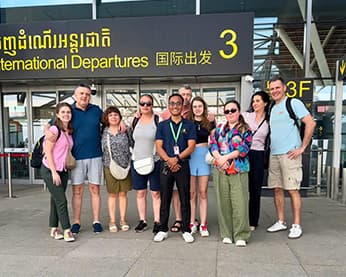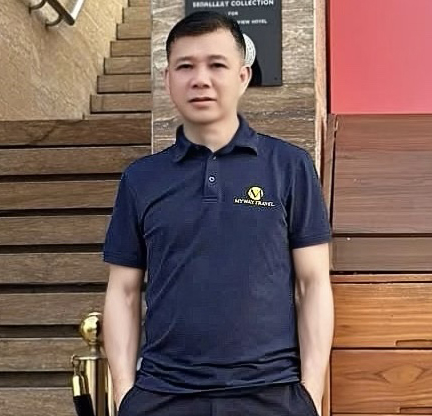Exploring the Different Ethnic Groups of Sapa
Exploring Northern Vietnam is not the same without a trip to Sapa. This charming town is nestled in the Northwest mountains, just a 5-hour drive from Hanoi. Sapa is famous for its breathtaking natural landscapes, including terraced rice fields and stunning valley views. Moreover, Sapa is renowned for its diverse ethnic minority groups like the Hmong, Yao, Tay and Giay, each with their own distinct traditions, clothing, languages, and customs.
Red Dao People’s Costume
The Red Dao are also one of the most populous ethnic minorities in Sapa. They are easily recognized by their traditional attire, where red is the dominant color. A complete Red Dao costume consists of a scarf or hat, shirt, trousers, belt, and shin guards (called xa cap). The sleeves, collar, and back are intricately embroidered with red, yellow, and white threads, depicting motifs like pine trees, tiger footprints, and serrated shapes. These designs blend harmoniously to create striking and beautiful outfits.
Tay People’s Costume
Compared to other ethnic groups in Sapa, the Tay people’s attire is simpler and more understated. Both men and women wear dark blue shirts with round collars, two front pockets, and wide cloth belts wrapped around their waists.
Giay People’s Costume
The Giay people also have simple traditional clothing. Their outfits feature minimal embroidery and are often adorned only with colored fabrics around the collar and bodice.
Xa Pho People’s Costume
The costumes of the Xa Pho people are both durable and visually captivating. Their shirts and skirts are crafted from cotton fabrics featuring various patterns and colors. Though the designs are simple, they hold cultural significance, depicting motifs like hills, pine trees, and flowing water.
Traditional Crafts of Ethnic Minorities in Sapa
Sapa is home to numerous traditional crafts, preserved and passed down through generations by local ethnic groups. Here are some of the most fascinating crafts you can discover:
Brocade Weaving
Brocade weaving is practiced by many ethnic groups in Sapa, including the Dao, Hmong, and Tay people. Today, brocade products not only serve everyday needs but have also become popular souvenirs that remind visitors of Sapa. Villages like Lao Chai, Ta Van, Cat Cat, and Ta Phin are excellent places to explore the brocade weaving process. Creating a single brocade piece involves many meticulous steps – from peeling flax bark and spinning yarn to weaving, embroidering intricate patterns, and dyeing the fabric with indigo.
Silver Carving
Silver carving is another traditional craft practiced by some ethnic minorities in Sapa. This art demands great skill, patience, and experience passed down through generations. The process involves several stages, from preparing tools like furnaces, molds, and hammers to shaping and carving silver into various items such as bracelets, necklaces, rings, pins, and chains. Each piece is unique in its design and intricate patterns.
Brocade Embroidery
In addition to weaving, brocade embroidery is highly popular, particularly among the Red Dao and Xa Pho people. For ethnic women, embroidery is an essential skill for creating clothes and household items. Many girls begin learning this craft in primary or secondary school, mastering techniques for choosing threads, fabrics, and blending colors to create beautiful designs.
Indigo Dyeing and Batik Drawing
While visiting Sapa, you’ll often see people wearing indigo-colored clothing. Indigo dyeing is a significant cultural tradition, especially among the Tay and Hmong ethnic groups. Alongside indigo dyeing, Batik drawing is also widespread. The Batik technique involves drawing patterns on fabric with beeswax, which resists dye during the indigo-dyeing process. When the wax is removed, the fabric reveals vibrant and sophisticated designs.
Bamboo and Rattan Weaving
Hmong and Tay artisans skillfully use materials like bamboo and rattan to create everyday items. Their handiwork results in durable and beautifully crafted products, including baskets, bags, trays, boxes, flower vases, and more. These items are practical for daily life and make wonderful local souvenirs.
Traditional Cultural Festivals of Ethnic Minorities in Sapa
Visiting Sapa during festival times offers a fantastic opportunity to immerse yourself in the unique cultures of the region’s ethnic minorities. Here are some notable festivals:
Hmong People’s Gau Tao Festival
The Gau Tao Festival is one of the most important celebrations for the Hmong people, held during the Tet Lunar New Year. The festival is organized to pray for health, good fortune, and prosperous harvests in the coming year. It’s also a time for Hmong families to reunite. Visitors can enjoy various traditional games and activities, such as horse fighting, crossbow shooting, flute dancing, and cockfighting.
Red Dao People’s Tet Nhay Festival
The Tet Nhay Festival of the Red Dao people takes place on the first and second days of the Lunar New Year. Before the festivities, young men in the village gather to rehearse dances, while the women embroider new clothing and prepare their finest outfits for the year’s biggest celebration. Once rituals conclude, the community joins together in singing, dancing, drinking, and lively conversation, creating a festive and warm atmosphere.
Xa Pho People’s Village Sweeping Rite
Held in February of the lunar calendar, the Xa Pho people’s village sweeping rite is a unique ceremony meant to drive away bad luck and bring peace, abundant harvests, and healthy livestock in the new year. Following the rituals, villagers engage in games and celebrations that last until midnight. The festival’s distinctive customs make it a must-see cultural event in Sapa.
In conclusion, Sapa offers rich insights into the lives, customs, and artistry of its diverse ethnic communities. Come and explore the colorful world of traditional crafts, vibrant costumes, and lively festivals that define the culture of Sapa’s ethnic minorities!



